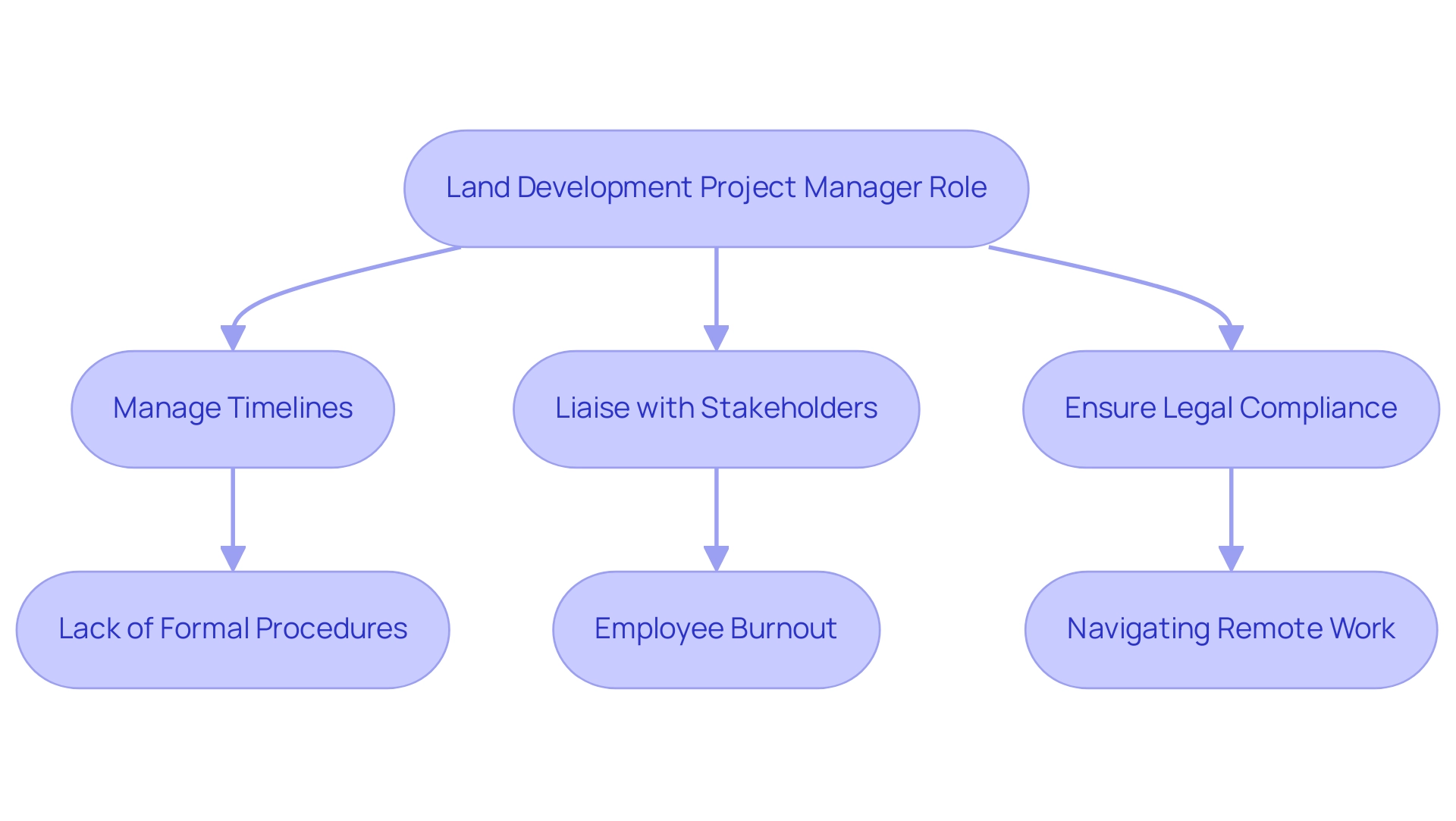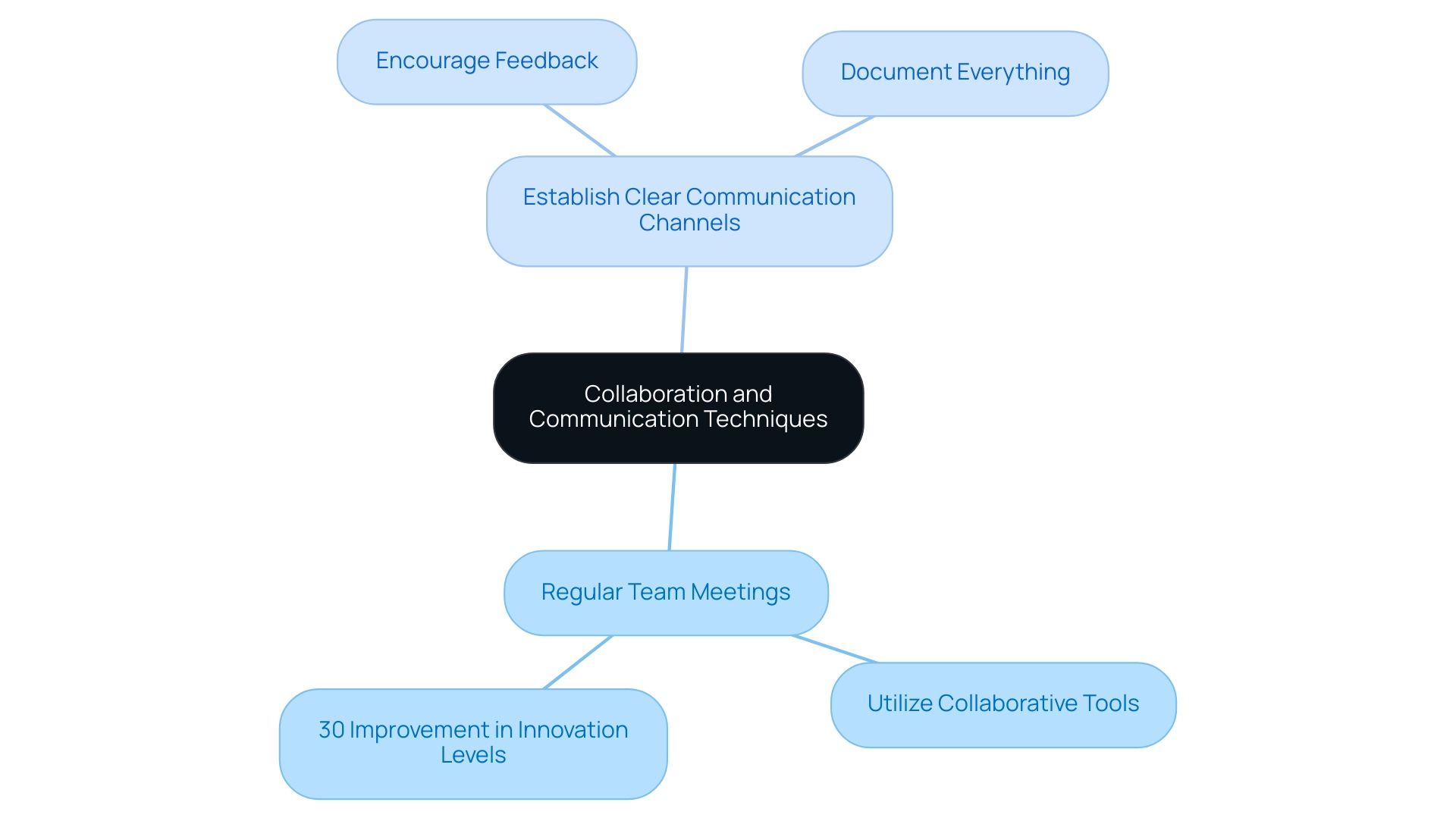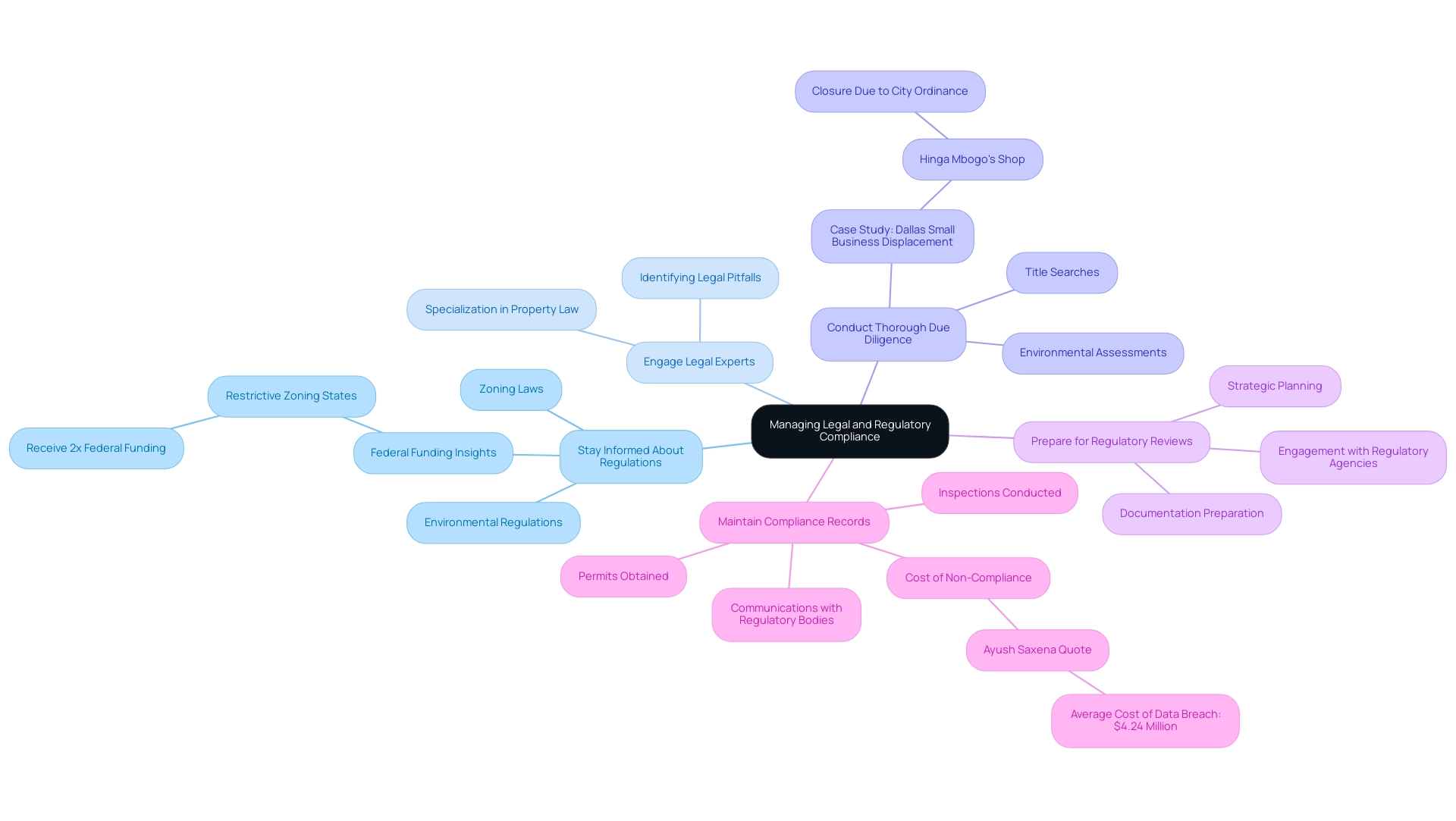Introduction
The intricate world of land development hinges on effective project management, where the role of a Land Development Project Manager becomes paramount. Tasked with overseeing every phase from conception to completion, these professionals navigate a complex landscape filled with diverse stakeholders, regulatory requirements, and unforeseen challenges. Their ability to foster collaboration, implement strategic risk management, and adapt to evolving circumstances is crucial for ensuring project success.
As organizations increasingly recognize the importance of robust project management practices, understanding the key strategies and tools available to these managers is essential. This article delves into the multifaceted responsibilities of Land Development Project Managers, exploring proven strategies for effective management, enhancing communication, and navigating legal compliance, all while leveraging technology to optimize project outcomes in a rapidly changing environment.
The Role of a Land Development Project Manager in Successful Coordination
The role of a Land Development Manager is integral to the successful land project coordination of land endeavors, as they oversee each phase from initial planning to execution and completion. Key responsibilities in land project coordination encompass:
- Managing timelines
- Liaising with diverse stakeholders—including landowners, government agencies, and contractors
- Ensuring adherence to legal and regulatory requirements
Effective communication is paramount; fostering collaboration among team members not only helps mitigate risks such as delays and budget overruns but also encourages a culture of proactive problem-solving.
A study shows that one-third of program leaders do not regularly interact with risk practices, highlighting the necessity for strong leadership in this field. Moreover, fostering a culture of overseeing initiatives is essential for organizational success, as only 46% of surveyed companies acknowledge its significance. Organizations also encounter difficulties in overseeing initiatives, including:
- A lack of formal procedures
- Employee burnout
- Navigating the remote work environment
The capability to adjust to changing situations and address disputes among stakeholders is crucial for success, emphasizing the leader's critical role in attaining objectives both efficiently and effectively. As mentioned by PMI, only 47% of organizations have a clearly defined career path for those overseeing projects, emphasizing the significance of joining organizations that prioritize maturity in oversight for professional growth. This context is further enriched by the under-researched relationship between Management Offices (PMO) and organizational performance measurement, indicating a gap that managers can help bridge.

Proven Strategies for Effective Land Project Management
To enhance the effectiveness of land project management, implementing the following proven strategies can significantly improve outcomes:
- Establish Clear Goals and Objectives: Initiating each endeavor with well-defined goals and measurable objectives is crucial. This clarity not only aligns all stakeholders but also ensures that every participant is focused on achieving the same outcomes. Expert insights suggest that initiatives with specific goals are 50% more likely to succeed.
- Utilize Advanced Technology: Embracing cutting-edge tools such as GIS mapping, ClickUp Dashboards, and AI-powered title research software can streamline data processing and enhance accuracy in land assessments. These technologies offer real-time updates and tracking for managers, significantly enhancing efficiency and reducing manual errors, making them essential elements of contemporary management.
- Foster Strong Stakeholder Relationships: Building and maintaining positive relationships with all stakeholders is essential. Regular communication and updates can manage expectations and help resolve conflicts before they escalate, ultimately leading to smoother execution. According to a recent PMI report, organizations with strong stakeholder engagement experience a 20% increase in success rates.
- Implement a Risk Management Plan: Identifying potential risks early in the initiative lifecycle and developing mitigation strategies is paramount. A proactive approach not only prevents delays but also helps avert cost overruns associated with unforeseen challenges, ensuring that endeavors stay within budget and on schedule.
- Regularly Review Progress: Conducting periodic evaluations to assess milestones allows for necessary adjustments and timely interventions when issues arise. This practice keeps the initiative on track and can lead to improved efficiency, as organizations that regularly monitor progress are 30% more likely to meet their goals.
Furthermore, the increasing acknowledgment of program administration as an essential career choice is demonstrated in a case study that emphasizes that 61% of firms provide training for program administration, with 47% having established career paths for program coordinators. This underscores the importance of these strategies in a competitive landscape.
Additionally, as Haillie Parker points out, "20 Free Planning Templates" can serve as useful tools for individuals seeking to improve their planning and execution processes.
By employing these strategies, development managers can navigate the complexities of their initiatives more effectively, leading to successful land project coordination and execution. In an evolving landscape where over 1.2 million professionals hold PMP certifications worldwide, staying ahead with these approaches is critical for sustained success.
Collaboration and Communication Techniques
To enhance collaboration and communication in land development, it is essential to implement the following techniques:
-
Regular Team Meetings: Establishing consistent check-in meetings creates a platform for team members to discuss progress, challenges, and upcoming tasks. This practice fosters a culture of transparency and encourages sharing of insights and solutions. Research indicates that regular collaboration can lead to a 30% improvement in innovation levels, as highlighted by Frost & Sullivan, emphasizing the critical role of these meetings in driving success.
- Utilize Collaborative Tools: Using task coordination software like Trello, Asana, or Microsoft Teams enables real-time teamwork and effective information exchange. These tools play a pivotal role in ensuring that all team members remain aligned, regardless of their geographic locations. As the online management software market is anticipated to reach $13.7 billion by 2030, investing in these technologies is increasingly essential for teams. For instance, Running has effectively utilized online collaboration tools to enhance efficiency and employee wellbeing, demonstrating the positive impact of these technologies on teamwork.
-
Establish Clear Communication Channels: Defining explicit protocols for communication is crucial to ensure that all team members understand how and when to share information. This can involve establishing dedicated email threads, group chats, or forums designed for specific tasks, which enhances the overall clarity and efficiency of communication.
- Encourage Feedback: Cultivating an environment where team members feel empowered to provide feedback on processes and strategies is vital. Consistently seeking feedback enhances cooperation and aids in tackling possible problems in advance, resulting in more efficient management.
- Document Everything: Maintaining comprehensive documentation of decisions, changes, and milestones ensures transparency and keeps stakeholders informed. This practice also serves as a valuable reference for future endeavors, enhancing the overall efficiency of task coordination practices.
By applying these techniques, coordinators can create a collaborative atmosphere that enhances land project coordination, boosts teamwork, and drives successful outcomes. A study by IDC revealed that nearly 48% of businesses expected to raise their budget for collaboration software, which highlights the significance of effective communication strategies in overseeing tasks. This trend emphasizes the increasing acknowledgment among organizations of the necessity for strong communication strategies to adjust to changing demands.

Managing Legal and Regulatory Compliance
Effective management of legal and regulatory compliance in property project management demands a diligent and proactive approach. Here are key best practices to consider:
- Stay Informed About Regulations: Continuously monitor local, state, and federal regulations that influence use and development. This encompasses zoning laws, environmental regulations, and relevant property acquisition statutes. Notably, states with more restrictive zoning receive nearly two times the federal funding per capita compared to their less restrictive counterparts, underlining the importance of understanding local contexts in compliance efforts. For instance, California ranks in the middle for land-use and zoning regulation, but this average masks significant variation within the state, which can impact funding and compliance strategies.
- Engage Legal Experts: Collaborate with legal professionals who specialize in property use and environmental law. Their expertise is crucial in ensuring that every aspect of the endeavor aligns with relevant statutes, helping to identify potential legal pitfalls early in the process.
- Conduct Thorough Due Diligence: Before proceeding with property acquisition, undertake comprehensive due diligence that encompasses title searches, environmental assessments, and reviews of existing use restrictions. Such thorough investigations can prevent costly legal complications down the line. A poignant example is the case of Hinga Mbogo's shop in Dallas, which faced closure due to a city ordinance despite being a non-conforming use since 1986. This incident highlights the vulnerability of small businesses to regulatory changes and underscores the necessity of meticulous due diligence.
- Prepare for Regulatory Reviews: Formulate a strategic plan for navigating the complex regulatory review processes and permitting requirements. This should include preparing all necessary documentation and proactively engaging with relevant regulatory agencies to address potential concerns early.
- Maintain Compliance Records: Keep comprehensive records of all compliance efforts, including permits obtained, inspections conducted, and communications with regulatory bodies. This documentation is invaluable in demonstrating adherence to regulatory requirements should any issues arise. As Ayush Saxena noted, "The average cost of a data breach per incident in 2021 among companies surveyed reached $4.24 million, the highest in 17 years." This highlights the financial consequences of non-compliance, emphasizing the necessity for careful management of legal and regulatory elements in development initiatives.
By implementing these best practices, managers can adeptly navigate the complexities of legal and regulatory compliance, effectively minimizing the risk of costly setbacks. As regulatory landscapes change, keeping informed of legal compliance updates will be essential for successful development initiatives throughout 2024 and beyond.

Leveraging Technology for Enhanced Project Efficiency
To effectively utilize technology in site management, it is essential to consider the following approaches:
- Adopt Project Management Software: Platforms such as Monday.com and Smartsheet facilitate enhanced task tracking, resource allocation, and project scheduling. These tools streamline communication, allowing for greater accountability and coordination among team members.
- Implement GIS Mapping: Geographic Information Systems (GIS) provide invaluable insights into usage, zoning regulations, and environmental considerations. The implementation of GIS mapping not only enhances decision-making but also supports more informed planning processes critical to successful land development.
- Utilize Data Analytics: Employing data analytics tools enables managers to analyze key performance metrics, revealing opportunities for improvement. This data-focused method enhances resource distribution and timelines, ensuring more efficient outcomes.
- Explore AI Solutions: Investigating AI-powered software can significantly automate repetitive tasks, such as title research and document management. This automation enables team leaders to concentrate their efforts on more strategic responsibilities, enhancing overall initiative focus and efficiency.
- Enhance Communication with Virtual Platforms: Utilizing video conferencing tools like Zoom or Microsoft Teams can facilitate regular communication with remote teams and stakeholders. This guarantees alignment and engagement, irrespective of geographical barriers.
By incorporating these technological solutions, project managers can improve project efficiency and ensure successful land project coordination for development initiatives. As noted in Deloitte's Digital Maturity Index, while the number of organizations embracing digital skills is increasing, the proportion of those achieving high levels of digital maturity remains relatively low. This emphasizes the ongoing need for firms to adopt advanced technologies, including GIS, to remain competitive in the evolving landscape of property services and consulting.
Furthermore, a case study from the Demba Gofa District illustrated the effectiveness of land utilization technologies, revealing that a two-stage sampling technique was successfully applied to assess adoption rates among local households. Furthermore, considering the average number of employees in treatment units (4.1604) compared to control units (4.1809) can provide valuable insights into resource allocation and efficiency in project management.
Conclusion
The responsibilities of a Land Development Project Manager are multifaceted and critical to the success of land projects. By effectively coordinating all phases of development, from planning to execution, these professionals ensure that projects are completed on time, within budget, and in compliance with legal requirements. The integration of clear goals, advanced technology, and strong stakeholder relationships forms the bedrock of successful project management. Implementing a robust risk management plan and regularly reviewing project milestones further enhances the likelihood of achieving desired outcomes.
Moreover, fostering collaboration and communication among team members is essential. Regular meetings and the use of collaborative tools can significantly improve transparency and innovation, driving project success. Understanding and adhering to legal and regulatory frameworks is equally important; engaging legal experts and conducting thorough due diligence can mitigate potential risks and complications.
As technology continues to evolve, leveraging innovative tools such as project management software, GIS mapping, and data analytics is crucial for enhancing efficiency and effectiveness in land development. By embracing these strategies and tools, Land Development Project Managers can navigate the complexities of their roles, ultimately leading to successful project outcomes in a dynamic environment.
In summary, the pivotal role of a Land Development Project Manager cannot be overstated. Their ability to adapt, communicate, and implement strategic practices is vital for the successful coordination of land projects. As organizations increasingly prioritize project management maturity, investing in the development of these professionals will be essential for fostering success in the ever-evolving landscape of land development.
Frequently Asked Questions
What is the role of a Land Development Manager?
A Land Development Manager is responsible for overseeing the successful coordination of land projects from initial planning to execution and completion. Their key responsibilities include managing timelines, liaising with stakeholders, and ensuring compliance with legal and regulatory requirements.
Why is effective communication important in land project management?
Effective communication fosters collaboration among team members, helping to mitigate risks such as delays and budget overruns. It also encourages a culture of proactive problem-solving, which is essential for successful project execution.
What are some common challenges faced by organizations in overseeing initiatives?
Organizations often face challenges such as a lack of formal procedures, employee burnout, and difficulties navigating the remote work environment.
What strategies can enhance the effectiveness of land project management?
Key strategies include establishing clear goals and objectives, utilizing advanced technology, fostering strong stakeholder relationships, implementing a risk management plan, and regularly reviewing progress.
How can technology improve land project management?
Technology can streamline data processing and enhance accuracy through tools like GIS mapping and AI-powered software. These technologies provide real-time updates and tracking, significantly improving efficiency and reducing manual errors.
What techniques can enhance collaboration and communication in land development?
Techniques include regular team meetings, utilizing collaborative tools like Trello or Asana, establishing clear communication channels, encouraging feedback, and maintaining comprehensive documentation.
What best practices should be followed for legal and regulatory compliance in property project management?
Best practices include staying informed about regulations, engaging legal experts, conducting thorough due diligence, preparing for regulatory reviews, and maintaining compliance records.
How can project managers effectively utilize technology in site management?
Project managers can adopt project management software, implement GIS mapping, utilize data analytics, explore AI solutions, and enhance communication with virtual platforms to improve project efficiency.
What is the significance of stakeholder engagement in project success?
Strong stakeholder engagement can lead to a 20% increase in success rates for organizations, making it essential for managing expectations and resolving conflicts effectively.
What are the implications of the study regarding program leaders and risk practices?
The study indicates that one-third of program leaders do not regularly interact with risk practices, highlighting the need for strong leadership and a culture of oversight in project management.
List of Sources
- The Role of a Land Development Project Manager in Successful Coordination
- 20 Project Management Statistics to Know in 2024 (https://fitsmallbusiness.com/project-management-statistics)
- Project Management Tools Statistics 2025 – Everything You Need to Know (https://llcbuddy.com/data/project-management-tools-statistics)
- mdpi.com (https://mdpi.com/2571-905X/6/3/54)
- explodingtopics.com (https://explodingtopics.com/blog/project-management-stats)
- Proven Strategies for Effective Land Project Management
- 31 Must-Know Project Management Statistics in 2025 (https://proofhub.com/articles/project-management-statistics)
- Project Management Statistics and Trends in 2024 | ClickUp (https://clickup.com/blog/project-management-statistics)
- Project Management Statistics You Need to Know 2024 (https://breeze.pm/blog/project-management-statistics)
- Collaboration and Communication Techniques
- Top 65+ Project Management Statistics for 2024 | PPM Express (https://ppm.express/blog/project-management-statistics)
- Team Collaboration | Spike Blog (https://spikenow.com/blog/team-collaboration/workplace-collaboration-statistics)
- Collaboration Counts: Eye-Opening Teamwork Statistics for 2025 | Runn (https://runn.io/blog/teamwork-statistics)
- Managing Legal and Regulatory Compliance
- sciencedirect.com (https://sciencedirect.com/science/article/abs/pii/S009411902100019X)
- 100+ Compliance Statistics You Should Know (https://sprinto.com/blog/compliance-statistics)
- rtp.fedsoc.org (https://rtp.fedsoc.org/paper/the-land-use-labyrinth-problems-of-land-use-regulation-and-the-permitting-process)
- cato.org (https://cato.org/policy-analysis/zoning-land-use-planning-housing-affordability)
- Leveraging Technology for Enhanced Project Efficiency
- Use of proptech in real estate U.S. 2022 | Statista (https://statista.com/statistics/1286977/prop-tech-adoption-by-us-companies)
- Real Estate Economics | AREUEA Journal | Wiley Online Library (https://onlinelibrary.wiley.com/doi/full/10.1111/1540-6229.12504)
- Key Statistics on Digital Adoption and How to Make Yours a Success - ERP Software Blog (https://erpsoftwareblog.com/2023/10/key-statistics-on-digital-adoption-and-how-to-make-yours-a-success)
- Impact of integrated land management technology adoption on rural livelihoods in the Goyrie watershed, Southern Ethiopia: Endogenous switching regression modeling estimation (https://tandfonline.com/doi/full/10.1080/23311886.2024.2391532)




